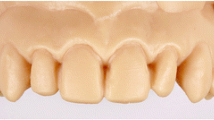Abstract
Purpose of Review
Within this review, the current needs of the dental industry will be discussed with special focus on additive manufacturing (3D printing) of dental restorations. Up to now, subtractive manufacturing methods are state of the art for production of monolithic restorations. Here, the challenges and opportunities currently existing for 3D printing of crowns and bridges will be evaluated.
Recent Findings
Over the last 10 years, the LCM technology has evolved to the state of the art 3D printing technique for dense and precise ceramics. A case study will present here the full digital workflow from acquiring the data of the patient to manufacturing the final restoration.
Summary
It can be shown that with the LCM technology, it is possible to manufacture highly accurate parts with exceptional good surface quality. Furthermore, it can be shown that established techniques for staining and glazing conventionally manufactured restorations are also perfectly suitable for parts manufactured by means of the LCM technology. Particularly attractive restorations and outstanding reproduction of the sharp-edged crown margins are possible, together with the exact reproduction of the occlusal surfaces with sharp and natural replication of the fissures.




Similar content being viewed by others
References
Papers of particular interest, published recently, have been highlighted as: • Of importance
Drei Buchstaben für ein Original–Die VMK-Technik. VITA Info. 2015;1:12–4.
Rosenblum MA, Schulman A. A review of all-ceramic restorations. J Am Dent Assoc. 1997;128:297–307.
McLean JW. Evolution of dental ceramics in the twentieth century. J Prosthet Dent. 2001;85:61–6.
Devigus A, Lombardi G. Shading Vita In-ceram YZ substructures: influence on value and chroma, part II. Int J Comput Dent. 2004;7:379–88.
Guazzato M, Albakry M, Ringer SP, Swain MV. Strength, fracture toughness and microstructure of a selection of all-ceramic materials. Part II. Zirconia-based dental ceramics. Dent Mater. 2004;20:449–56.
Hannink RHJ, Kelly PM, Muddle BC. Transformation toughening in zirconia-containing ceramics. J Am Ceram Soc. 2000;83:461–87.
Piconi C, Maccauro G. Zirconia as a ceramic biomaterial. Biomaterials. 1999;20:1–25.
Teixeira EC, Piascik JR, Stoner BR, Thompson JY. Dynamic fatigue and strength characterization of three ceramic materials. J Mater Sci Mater Med. 2007;18:1219–24.
Heintze SD, Rousson V. Survival of zirconia- and metal-supported fixed dental prostheses: a systematic review. Int J Prosthodont. 2010;23:493–502.
Beuer F, Stimmelmayr M, Gernet W, Edelhoff D, Guh JF, Naumann M. Prospective study of zirconia-based restorations: 3-year clinical results. Quintessence Int. 2010;41:631–7.
Rinke S, Fischer C. Range of indications for translucent zirconia modifications: clinical and technical aspects. Quintessence Int. 2013;44:557–66.
• Beuer F, Stimmelmayr M, Gueth JF, Edelhoff D, Naumann M. In vitro performance of full-contour zirconia single crowns. Dent Mater. 2012;28:449–56 In this publication, the outstanding properties of fully anatomical zirconium oxide crowns are scientifically presented.
Schweiger J, Güth JF. IDS Highlights 2019–Digitale Welten–Datenerfassung und Manufacturing. Teamwork J CONT DENT EDUC. 2019;22(2):108–21.
• Schweiger J, Beuer F, Stimmelmayr M, Edelhoff D, Magne P, Güth JF: Histo-anatomic 3D printing of dental structures. BrDentJ 2016; 221(9): 555-560. This article gives an outlook on the future possibilities of additive manufacturing of nature-identical dental prostheses.
Schweiger J. Method, apparatur and computer program for producing a dental prosthesis. US8,775,131,B2, 2011
• Schweiger J. Method, apparatur and computer program for producing a dental prosthesis. EP 2 363 094 B1 2011. This patent forms the basis for the histo-anatomical fabrication of dental prostheses.
Author information
Authors and Affiliations
Corresponding author
Ethics declarations
Conflict of Interest
The authors declare that they have no conflicts of interest.
Human and Animal Rights
This article does not contain any studies with human or animal subjects performed by any of the authors.
Additional information
Publisher’s Note
Springer Nature remains neutral with regard to jurisdictional claims in published maps and institutional affiliations.
This article is part of the Topical Collection on Modern Production Laboratory Advances in Dental Technology
Rights and permissions
About this article
Cite this article
Schweiger, J., Bomze, D. & Schwentenwein, M. 3D Printing of Zirconia–What is the Future?. Curr Oral Health Rep 6, 339–343 (2019). https://doi.org/10.1007/s40496-019-00243-4
Published:
Issue Date:
DOI: https://doi.org/10.1007/s40496-019-00243-4




